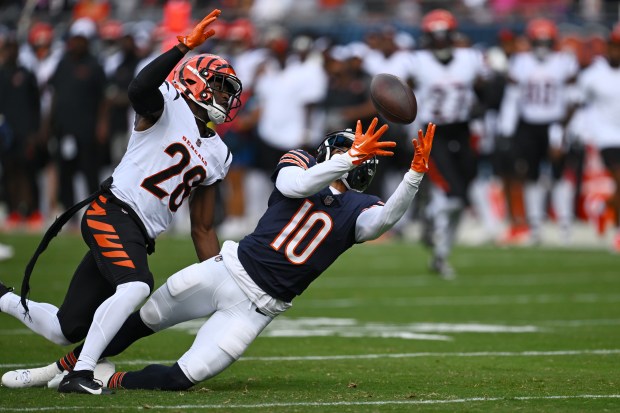After defeating the Cincinnati Bengals 27-3 on Saturday at Soldier Field, the Chicago Bears have one last preseason game Thursday in Kansas City before crossing the bridge into the regular season.
The Bears have to set their initial 53-man roster next week and have plenty of work to do before being ready for Week 1, but things seem to be trending in the right direction. As the game with the Chiefs nears, here’s the inside slant on three notable storylines.
Talking points
For far too long Saturday afternoon, the Bears offense seemed disjointed, rickety, out of sorts. In the team’s only home preseason game, rookie quarterback Caleb Williams and the first-team were struggling to get anything going against a Cincinnati Bengals defense that had opted to rest its starters.
First Bears possession: three-and-out.
Second drive: ditto.
Third series? Yep. Another Tory Taylor punt.
When the first quarter ended, the Bears didn’t have a first down. Williams had more penalty yards — 15 on a questionable intentional grounding infraction — than passing yards (12). The hopes of teasing an eager Soldier Field crowd with flashes of potential seemed to be fading.
But then it happened. Three minutes into the second quarter, the Bears picked up their first first down with 16 yards on a nifty end-around by rookie wide receiver Rome Odunze. And on the next snap — first-and-10 from the Bears 42 — Williams went to work.
Under center, play fake to running back Travis Homer. Then, in rhythm, Williams launched a deep shot to Tyler Scott. From the press box at Soldier Field, it was a gorgeous ball to a receiver with separation.
Scott, without breaking stride, reached to pull in what might have been a touchdown but instead was pulled down from behind by cornerback Josh Newton for a pass interference penalty. Those 43 yards weren’t reflected in Williams’ ordinary final stat line: 6-for-13 passing, 75 yards, 64.6 rating. But without question, that shot play seemed to energize Williams and the offense.
Williams acknowledged that Newton’s penalty agitated his competitive side. When he let the ball go, he thought he had connected for a touchdown.
“I was a little irked because I really wanted that, to be honest with you,” he said. “I tried to give him enough air so he could run under it and run away from the guy. The cornerback pulled him and we got the PI. But I think we would have ran under it and scored a touchdown if not.”
There was more to that play than first met the eye.
As Williams described the sequence from his vantage point, he spoke with as much detail as he exuded confidence. He described how he recognized the slot cornerback playing flat-footed just as Scott broke past. He noted how the deep safety came down to account for an over route by Odunze. He recognized an ideal window opening.
“Then,” Williams continued, “the backside corner (Allan George) tried to invert and get over the top of that. We teach (the receivers) to stay up and don’t cross the hash. Because that backside corner would never be able to make that play. Tyler did that.”
Scott did that. Williams did his thing.
The Bears moved inside the red zone with the big gain and pocketed another valuable rep that will aid their rookie quarterback’s development.
Despite the disappointing start, Williams and the Bears left Soldier Field with a 27-3 victory and several encouraging flashes. Included in the highlight montage was an exhilarating 7-yard touchdown scramble on Williams’ final snap as well as his off-script, 45-yard seed to Odunze down the left sideline earlier in that possession.
In describing the latter play, an on-the-move, across-his-body laser that fell perfectly into Odunze’s hands, Williams cited one of his QB role models — Aaron Rodgers — for inspiring him to add such tricks to his bag.
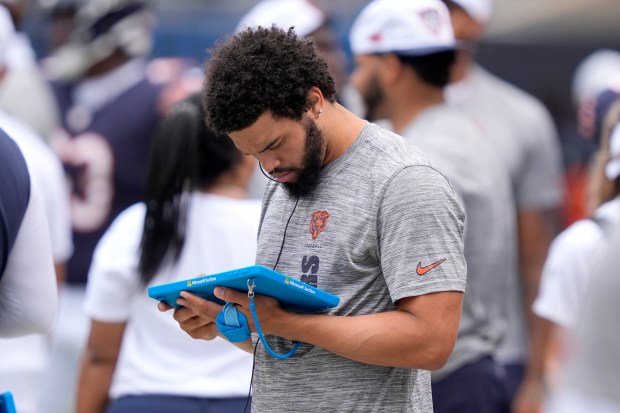
In the postgame news conference, Williams’ description of the deep shot to Scott also seemed Rodgersesque, another example of the way Williams sees, feels and explains the game. That’s no small deal.
So many times over Rodgers’ 15 seasons as the Green Bay Packers starter, he would torture the Bears with his playmaking precision and gusto, then sit calmly — almost diabolically — at his postgame news conference and recount, in vivid detail, how he had gutted the Bears defense.
In 2020, after orchestrating a 41-25 massacre of the Bears at Lambeau Field, Rodgers spent nearly two minutes dissecting one seemingly effortless 12-yard touchdown pass to Davante Adams.
He talked first about what he diagnosed immediately upon taking the snap. He detailed the route combination between Adams and tight end Robert Tonyan and a potential improvisation he was anticipating from Adams.
He described how his initial preference to throw to Tonyan was disrupted because Tonyan slipped but how he had the calm to reset in the pocket because he trusted the extra protection the Packers had devoted to Khalil Mack.
Finally, Rodgers described the soft spot he recognized in the Bears defense and the precise location in the end zone he was looking to place his throw to Adams.
Easy as that. Touchdown.
Now that’s what quarterback command looks and sounds like.
So often, Bears fans would live all that Rodgers mastery — the on-field surgery, the off-field aplomb — and sigh with envy.
Sure would be nice to have a QB like that one day.
On Saturday, Williams provided a glimpse into that side of his quarterback toolbox, expressing how much of a stickler for details he is and how he can feel and explain the game.
“It’s honestly crazy how slow the game is for him as a guy who’s in Year 1,” Scott said. “It’s exactly what you want from a quarterback, where he feels like he can just kind of control everything.”
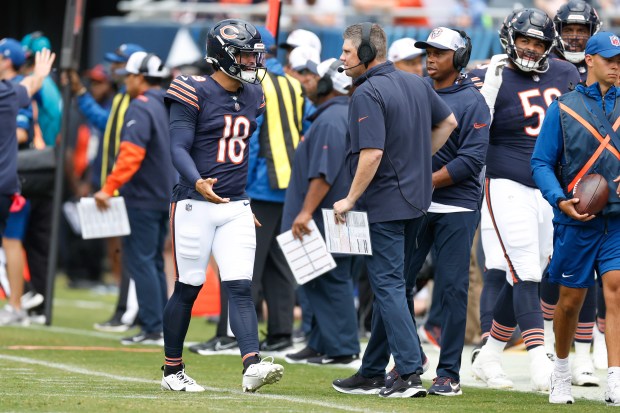
Bears offensive coordinator Shane Waldron has spent much of the spring and summer lauding Williams’ spatial awareness and the quarterback feel that allows him to react and maneuver inside chaos with such grace.
“It almost seems like it’s in slow motion for him,” Waldron said Monday.
Along with that, Waldron acknowledged, Williams has an advanced ability, especially for a rookie, not only to understand what he is seeing, but also to explain it through his lens to coaches and teammates.
“It’s a great trait that he has,” Waldron said. “When we get over to the sideline to look at the (Microsoft) Surface, before you even look at the Surface he can already tell you the why behind each read.
“To me that’s the most important part. If he’s not seeing it clearly, that’s where you really need to go back through it. But he sees it clearly.”
It wasn’t just the deep shot to Scott that Williams described so clearly. He seemed as immersed in recounting the offense’s early struggles and the little wrinkles that need to be ironed out.
“The small things,” Williams said, “always add up to big things. … It always adds up. They’re super minute, super small things. But in the game of football, you only have split seconds. And those little things add up.”
Oh, and after the 45-yard completion to Odunze that sent Soldier Field into hysterics? Scott noted how Williams immediately addressed Odunze in the huddle with a point or two on how his original route could have been sharper.
“He’s in the huddle talking about everything he just saw,” Scott said. “Just like, ‘Man, I was expecting you to do this, that and the third on your initial route.’ The next play is coming up and still he’s in there teaching.
“Once again, that’s just his mindset and how fast his mind is working and how fast everything is calculating in his head.”
Scott doesn’t apologize for making a reference to this week’s preseason opponent, the Kansas City Chiefs, and their three-time Super Bowl champion quarterback, Patrick Mahomes. Scott watched Mahomes dismantle the Bears in Week 3 a year ago and came away with a lasting impression.
“The biggest thing you see with him is that everything is so under control,” Scott said. “He looks like he knows everything that is going on around him. It’s like he’s constantly a step ahead of everything and everyone. It’s as if it’s all moving in slow motion. He’s controlling it all.”
Scott smiled.
“You’re seeing glimpses of that with Caleb and how he’s handling himself in the pocket and, obviously, when he’s scrambling,” Scott said. “It’s great to see. That gives you confidence as a receiver as well.
“You can feel how intentional he is as far as his own progress and his understanding of what we’re trying to get done and his understanding of his toolbox and how to use that in certain situations. You feel how important it is to him with how he’s processing and taking everything in.”
Growth spurt

For as much acclaim as Bears cornerback Kyler Gordon got over the weekend for his crushing blitz sack of Bengals quarterback Logan Woodside, his most impressive play may have come a quarter earlier.
Woodside floated a swing pass to the right flat to wide receiver Kwamie Lassiter II, and Gordon reacted promptly, knifed into the backfield and took down Lassiter for a loss of 3 yards.
That was a timely reminder of how good the Bears defense can be at full strength. And after returning last week from a three-week absence due to a calf issue, Gordon quickly lessened any concern about how ready he will be to make an impact when the season arrives.
“Turn the film on,” linebacker Tremaine Edmunds said of Gordon. “I mean, he was all over the field making plays. Whether it was blitzing, whether it was pass coverage, his run fits, it was almost like he had been out there with us the whole time. He didn’t miss one beat.”
From front to back, right to left, the Bears feel like they have a defense capable of being one of the league’s best in 2024, highlighted by an athletic and opportunistic group of playmakers in the secondary.
“It’s just a surge of energy,” Gordon said. “That’s kind of the way I’ve felt since the day we came in. From the first day, everyone is just like starving. Everyone wants to eat some type of way.”
Despite a variety of minor injury setbacks in August, the Bears seem to have built on the momentum they created late last season.
Over the final eight games, they totaled 16 interceptions and allowed only 17.1 points per game while finishing the year as the league’s stingiest run defense (86.4 yards per game). It felt like a springboard.
On the opening day of training camp last month, Edmunds was asked what he believed would carry over from last season’s strong finish.
“It starts with a belief,” he said. “That’s a simple answer. But at the end of the day it’s about belief, a belief that we can be as good as we say we can be. I think we showed that (late last season). I think that was an accomplishment, man.”
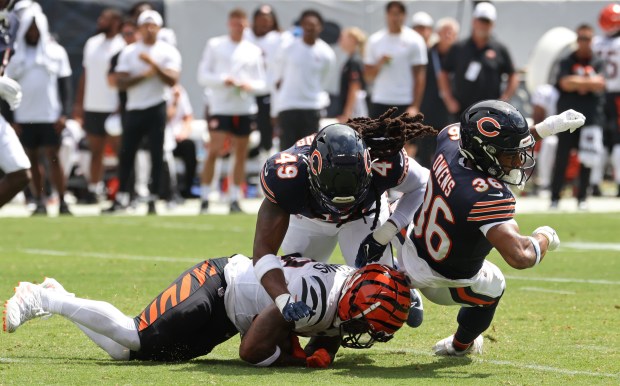
In Edmunds’ eyes, the Bears went from curiously asking, “How good can we really be?” to confidently asking, “How good can we really be?”
“Obviously you show glimpses of it and you show what you can truly do,” Edmunds said. “You have different guys making plays. With a good team, man, it’s not just one or two players. We had multiple people making plays day in and day out, week in and week out. And that’s what you want.”
That hasn’t changed over the past four weeks as the belief has grown and the chemistry has strengthened. The Bears have a Pro Bowl pass rusher in Montez Sweat, a potentially elite cornerback in Jaylon Johnson and a top-end linebacking duo in Edmunds and T.J. Edwards.
Mix in Gordon, improving defensive tackle Gervon Dexter, second-year corner Tyrique Stevenson and veteran safety Kevin Byard, and the jelling has been noticeable.
“At the end of the day,” Edmunds said, “it’s just seeing guys playing fast.”
The defense feels equipped to be the team’s engine early in the season as playoff aspirations inside Halas Hall fuel enthusiasm in the outside world. That, Edmunds said Monday, also matters.
“It’s just feeling the energy,” he said. “Whether it’s here at practice, whether it’s when you show up on game day, you can just feel that. That energy is contagious.
“As a player, you’re going to do everything in your power to deliver for the city because you know you have a lot of people behind you.”
Decisions: 2024
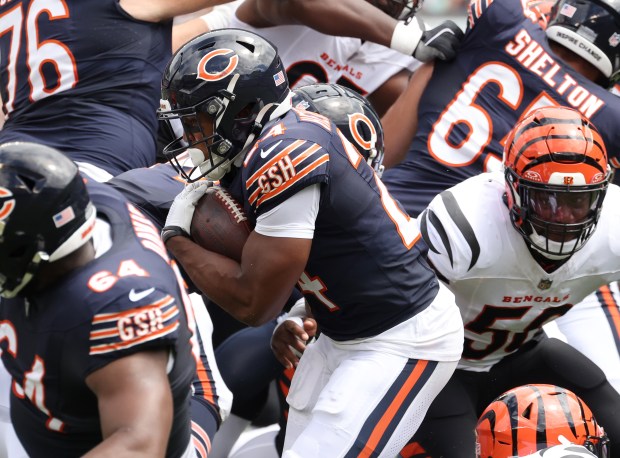
As the Bears head to Kansas City later this week, their depth chart is beginning to solidify. General manager Ryan Poles will have to submit his initial 53-man roster by 3 p.m. Aug. 27 and a day later can begin assembling a 17-player practice squad.
With 90 players on the camp roster, the squeeze isn’t as intense as it was a decade ago, when practice squads were less than half as big. Still, numerous players are fighting for their professional livelihoods this week and some big decisions lie ahead for Poles, coach Matt Eberflus and their staffs.
With that in mind, here are the five biggest roster questions lingering in the final week of the preseason:
Can Velus Jones, a third-round pick in 2022, do enough for the offense to secure a spot on the roster?
Our guess: No. Jones’ recent transition from wide receiver to running back felt born out of desperation more than a spark of creativity. Jones’ biggest value is as a kickoff returner. But as the Bears roster reaches a state of being legitimately competitive, they need players to fill the bottom of that roster who can do multiple things well.
In a crowded running back room that includes fullback Khari Blasingame and special teams standout Travis Homer, is Khalil Herbert in danger of being the odd man out?
Our guess: No. Some of this may hinge on how the Bears feel about Roschon Johnson as a viable RB2 option behind D’Andre Swift. And some may hinge on the special teams numbers game, which might create some squeeze in surprising places. Still, the Bears can easily justify keeping four running backs plus Blasingame, which would leave an opening for Herbert with undrafted rookie Ian Wheeler likely bound for the practice squad.
As a steady punt returner and veteran receiver, has Dante Pettis earned his way onto the 53-man roster?
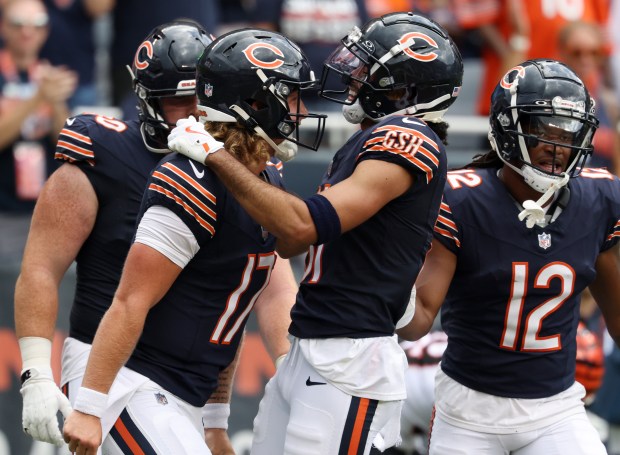
Our guess: Yes. Pettis had two second-half touchdown catches from Tyson Bagent on Saturday and, when healthy, remains a dependable route runner who is suited for a backup receiver role. His experience as a punt returner is the foot that keeps the door open for his Bears career to continue.
Might rookie Kiran Amegadjie’s return to the active roster alter the plans for offensive line depth?
Our guess: Yes. The Bears drafted Amegadjie with a vision of molding him into a swing tackle as a rookie. But his delayed return from quadriceps surgery altered those plans, with Matt Pryor likely to secure that swing role for Week 1. Still, Amegadjie will be on the 53-man roster, which puts added pressure on veteran Larry Borom to prove he’s worth keeping.
The Bears essentially have six starters in Braxton Jones, Teven Jenkins, Coleman Shelton, Ryan Bates, Nate Davis and Darnell Wright. They’ll be looking to keep three reserves on the roster. And with Pryor and Amegadjie likely, the top candidates for that final spot are probably Borom and Ja’Tyre Carter.
With the secondary the deepest position group on the roster, will Poles be forced into some tough cuts on the back end next week?
Our guess: Yes. Sharpie in Jaylon Johnson, Kyler Gordon, Tyrique Stevenson, Kevin Byard and Jaquan Brisker as your secondary starters. Hold backup/special teams spots for Josh Blackwell, Terell Smith, Jonathan Owens and Elijah Hicks. Then what?
With likely two more roster openings, there could be a battle among Jaylon Jones, Greg Stroman Jr., Reddy Stewart and perhaps Adrian Colbert to fill out the 53. It won’t be an easy call for Poles, but that’s the benefit of having a stronger roster with more quality depth.


